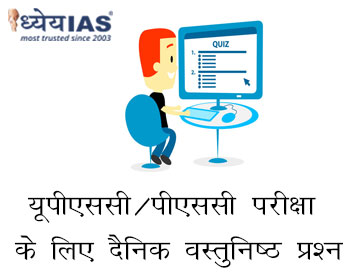Daily Static MCQs Quiz for UPSC, IAS, UPPSC/UPPCS, MPPSC. BPSC, RPSC & All State PSC Exams
Subject : Economy
1.Which of the following is/are included in the calculation of National Income in India?
1. Salary of employees
2. Exports of the IT sector
3. Sale of Land
How many of the above options is/are correct?
(a) Only one
(b) Only two
(c) All three
(d) None
Answer: (B)
Explanation:
- National Income is defined as the total monetary value of all goods and services produced within a country during a given period of time. Gains on sale of land will not be included in the estimation of National Income. Capital gains will not be included in the national income as they do not add to the current flow of goods and services in the economy. Hence, option (3) is not correct.
2. Consider the following statements:
1. The responsibility of conducting monetary policy is explicitly mandated under the Reserve Bank of India Act, 1934.
2. The primary objective of monetary policy is to maintain price stability without worrying about growth.
3. The flexible inflation targeting framework by RBI has statutory basis.
How many of the above statements is/are correct?
(a) Only one
(b) Only two
(c) All three
(d) None
Answer: (B)
Explanation: The Reserve Bank of India (RBI) is vested with the responsibility of conducting monetary policy. This responsibility is explicitly mandated under the Reserve Bank of India Act, 1934. The primary objective of monetary policy is to maintain price stability while keeping in mind the objective of growth. Price stability is a necessary precondition to sustainable growth. In May 2016, the Reserve Bank of India (RBI) Act, 1934 was amended to provide a statutory basis for the implementation of the flexible inflation targeting framework. Hence, statement 2 is not correct.
3. Consider the following statements regarding RBI’s Open Market Operations (OMOs):
1. OMOs can be used to tame short-term inflation in the economy.
2. They are to be mandatorily conducted once every year to adjust liquidity in the security markets.
3. No intermediaries such as commercial banks are involved in OMOs.
How many of the above statements is/are correct?
(a) Only one
(b) Only two
(c) All three
(d) None
Answer: (A)
Explanation: OMOs are conducted by the RBI by way of sale or purchase of government securities (g-secs) to adjust money supply conditions. RBI carries out the OMO through commercial banks and does not directly deal with the public. The central bank sells g-secs to suck out liquidity from the system and buys back g-secs to infuse liquidity into the system. These operations are often conducted on a day-to-day basis in a manner that balances inflation while helping banks continue to lend. The RBI uses OMO along with other monetary policy tools such as repo rate, cash reserve ratio and statutory liquidity ratio to adjust the quantum and price of money in the system. When the RBI wants to increase the money supply in the economy, it purchases the government securities from the market and it sells government securities to suck out liquidity from the system. Hence, only statement 1 is correct.
4.Which of the following situations can lead to inflation?
(a) Sluggish growth of aggregate demand
(b) Higher levels of unemployment
(c) Reduction in the money supply
(d) Rapid growth of aggregate demand outweighing supply
Answer: (D)
Explanation: Demand-pull inflation is a period of inflation which arises from rapid growth in aggregate demand. It occurs when economic growth is too fast. If aggregate demand (AD) rises faster than productive capacity (LRAS), then firms will respond by putting up prices, creating inflation. Hence, option (d) is correct.
5.Consider the following statements:
1.The Laffer curve is an economic concept that states that inflation and unemployment have a stable and inverse relationship.
2. The Phillips curve is an economic concept developed to show the relationship between tax rates and the amount of tax revenue collected by governments.
Which of the above statements is/are correct?
(a) 1 only
(b) 2 only
(c) Both 1 and 2
(d) Neither 1 nor 2
Answer: (D)
Explanation: The Phillips curve is an economic concept developed by A. W. Phillips stating that inflation and unemployment have a stable and inverse relationship.
The Laffer curve is a theory developed by supply-side economist Arthur Laffer to show the relationship between tax rates and the amount of tax revenue collected by governments. The curve is used to illustrate Laffer’s argument that sometimes-cutting tax rates can increase total tax revenue.
Hence, both statements are not correct.







